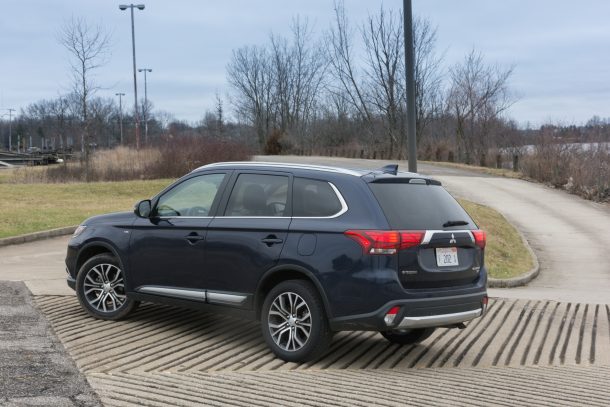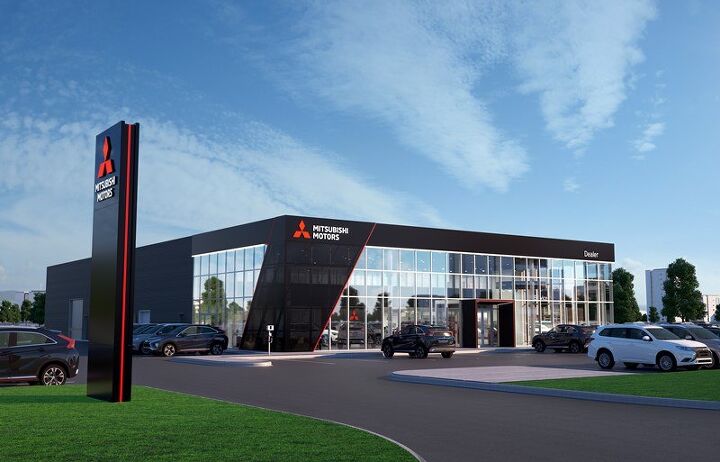It'll Take More Than a Dealership Makeover to Propel Mitsubishi Upmarket

At the end of the day, brand perception comes down to product, but no one likes visiting a dingy dealership. As the once-endangered Mitsubishi awaits a slew of lucrative new products (crafted with Nissan’s help), it figures it may as well begin sprucing up its dealer presence — not just in the U.S., but worldwide.
While the automaker’s U.S. division sits back and basks in the glow of June’s 46.2 percent year-over-year sale increase, head office is busy planning 5,000 renovations.
According to Automotive News, Mitsubishi plans to complete its dealer makeover within 6 years, by which time the alliance between the formerly destitute brand and its Renault-Nissan overlords should bear fruit. Maybe even a North American pickup truck, if certain execs get their way.
The dealer revamp kicked off on Independence Day at one West Virginia store and another in Texas. By the end of March 2019, Mitsubishi claims it should have 25 of its 354 stores looking fresh and new. Apparently, Mazda’s ongoing image overhaul provided something of a template — Mitsu’s preferred interior color scheme is black, white, and grey, while Mazda’s is black, white, and silver. Classy, premium colors, apparently, though Mazda bolsters the effect with the use of wood.
“The intent is to ensure consistent image of all outlets globally and enhance customer satisfaction,” Mitsubishi CEO Osamu Masuko said in June. “This will help further instill our brand in the markets.”
In Canada, Mitsubishi launched a country-wide modernization program early last year, with some dealers gaining wholly new stores. The global makeover applies here, too. Red accents and a “Dynamic Slope” will appear on the exterior of all stores, with well-lit showroom space residing under a black ceiling. Customers will apparently be well-greeted upon entering.
While many look at the brand’s current crop of products and think back wistfully to the days of the (real) Eclipse and 3000GT, today’s customers are buying what Mitsubishi’s selling. Thanks to a big volume increase from its utility vehicle portfolio, the brand’s U.S. sales rose 23.4 percent over the first six months of 2018. Last month was the brand’s best U.S. June showing in the since 2007. In Canada, it was the best June ever, with sales up 18 percent, year over year.
The aging Outlander remains the brand’s best-seller, with U.S. sales up 58.8 percent, year over year, in June. The oft-refreshed Outlander Sport posted a 25 percent YoY increase. Couple those sales with the recent addition of the Outlander PHEV and Eclipse Cross, and utility vehicle sales rose 64.4 percent compared to June 2017. If you’re curious, sales of the three-cylinder Mirage have only slipped 3.7 percent, year to date.
[Image: © 2018 Chris Tonn/TTAC, Mitsubishi Canada]

More by Steph Willems
Latest Car Reviews
Read moreLatest Product Reviews
Read moreRecent Comments
- Kjhkjlhkjhkljh kljhjkhjklhkjh A prelude is a bad idea. There is already Acura with all the weird sport trims. This will not make back it's R&D money.
- Analoggrotto I don't see a red car here, how blazing stupid are you people?
- Redapple2 Love the wheels
- Redapple2 Good luck to them. They used to make great cars. 510. 240Z, Sentra SE-R. Maxima. Frontier.
- Joe65688619 Under Ghosn they went through the same short-term bottom-line thinking that GM did in the 80s/90s, and they have not recovered say, to their heyday in the 50s and 60s in terms of market share and innovation. Poor design decisions (a CVT in their front-wheel drive "4-Door Sports Car", model overlap in a poorly performing segment (they never needed the Altima AND the Maxima...what they needed was one vehicle with different drivetrain, including hybrid, to compete with the Accord/Camry, and decontenting their vehicles: My 2012 QX56 (I know, not a Nissan, but the same holds for the Armada) had power rear windows in the cargo area that could vent, a glass hatch on the back door that could be opened separate from the whole liftgate (in such a tall vehicle, kinda essential if you have it in a garage and want to load the trunk without having to open the garage door to make room for the lift gate), a nice driver's side folding armrest, and a few other quality-of-life details absent from my 2018 QX80. In a competitive market this attention to detai is can be the differentiator that sell cars. Now they are caught in the middle of the market, competing more with Hyundai and Kia and selling discounted vehicles near the same price points, but losing money on them. They invested also invested a lot in niche platforms. The Leaf was one of the first full EVs, but never really evolved. They misjudged the market - luxury EVs are selling, small budget models not so much. Variable compression engines offering little in terms of real-world power or tech, let a lot of complexity that is leading to higher failure rates. Aside from the Z and GT-R (low volume models), not much forced induction (whether your a fan or not, look at what Honda did with the CR-V and Acura RDX - same chassis, slap a turbo on it, make it nicer inside, and now you can sell it as a semi-premium brand with higher markup). That said, I do believe they retain the technical and engineering capability to do far better. About time management realized they need to make smarter investments and understand their markets better.



































Comments
Join the conversation
Mitsubishi has always puzzled me. They are one of Japan's largest corporations, they own Mitsubishi Bank, and are affiliated with hundreds of businesses, like Mitsubishi electronics, etc., like other successful Japanese conglomerates. They partnered with Chrysler four decades ago to make small cars- succsessfully, and some of their cars were bulletproof, if not stylish- Dodge Colt foe example. Yet Three Diamonds has never quite put it all together for some reason.
Selling a cheap car and third rate CUV's and SUV's is not a recipe for success; but the fact that Mitsu is having sales increase so much is proof that subprime buyers have no standards. They want what everyone else wants and won't let mediocrity of product step in their way to claim they have a new car (with a loan at 18% to go with it). I'm happy with my 21 year old CAR. It gets 50 mpgs, cost $10k new, and employed American Autoworkers to build it.